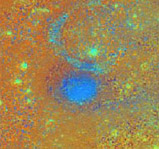2014 June 10
Two Lunar Projects – a call for observers
BAA observers have been invited to participate in two new lunar observing programmes, one led by Raffaello Lena of the Geologic Lunar Research Group, an international group coordinated from Rome, and the other by Rachael King of Aberystwyth University.
Raffaello is interested in receiving images taken under high incident illumination of a small dark pyroclastic deposit near the small crater Yangel on the northern edge of the Mare Vaporum. He writes as follows:
I am starting a campaign to encourage observers to image the small lunar pyroclastic deposit (LPD) located on the summit of the dome Yangel 1. The LPD was identified by Barry Fitz-Gerald and myself and a paper on it was published in a recent issue of the journal Planetary and Space Science (March 2014). The LPD is detectable in Clementine and Selene imagery, as shown in the mentioned article. The Yangel LPD is detectable in a Clementine albedo map and is characterized by high R415/R750 ratio. The Selene-1 (Kaguya) colour ratio image and Clementine UVVIS multispectral data indicate a higher titanium concentration for the dome and LPD, which show up bluer than the surrounding red mare.
To our knowledge this small deposit (4-5 km wide) has not been imaged from Earth. Hence, all imagers and enthusiastic lunar observers are asked to verify if this deposit is detectable using medium/large amateur telescopes. The goal of this project is to image the deposit under high solar illumination near full Moon. Of course, considering its small dimensions, high magnification is necessary. Colour images (including the supersaturation method) are also welcomed. Combined efforts including all eventual data received will be included in a future report on the visibility (from Earth) of the deposit. Negative results from CCD imagery would suggest that deposit has little obscuring effect on the underlying topography. I will be happy to receive any images for further analysis.’
The deposit lies at lunar coordinates 16.4°N; 3.3°E, and its position is shown on the image below.

This will be a difficult observation to make and will require high-resolution imaging using moderate or large-aperture telescopes, but it is well worth attempting at or around full Moon. The Moon at that phase is low in British skies over the summer months, so observations would be especially welcome from members in more southern latitudes. All images should be sent to Raffaello at: gibbidomine@libero.it. They should also be copied to me (w.leatherbarrow1@btinternet.com).
Meanwhile, Rachael is interested in trying to set up a lunar impact flash observing network with BAA Lunar Section members, and her project will be to see how to combine together light curves from several simultaneous video recordings of an impact flash. I have asked Rachael to write a piece for the next issue of the Lunar Section Circular, describing her project more fully. In the meantime she sends the following brief message:
I am a second year student studying at Aberystwyth university. I’m currently doing a project on lunar impact flashes and will be taking observations with two remotely controlled telescopes across the next year, when the weather is permitting and the Earthshine is optimal (having a good amount of shadow of the moon to allow the meteor impacts to show up). My main telescope is a 10″ Meade telescope. I am using the data from videos captured by the telescopes to produce a light curve of the impact flashes, with the main question being “how do atmospheric distortion and other factors affect an image of an impact flash?” To find this out I need to have as many independent sources of the same impact as possible, from various part of the UK. So my question is, do any of you take videos or images of lunar impact flashes or are planning to in the near future?
This sort of observational work could be accomplished by those equipped with video cameras suitable for occultation and meteor observations. It promises to be a useful project, and I would urge anyone interested in joining in to contact Rachael directly at rsk1@aber.ac.uk.
| The British Astronomical Association supports amateur astronomers around the UK and the rest of the world. Find out more about the BAA or join us. |
